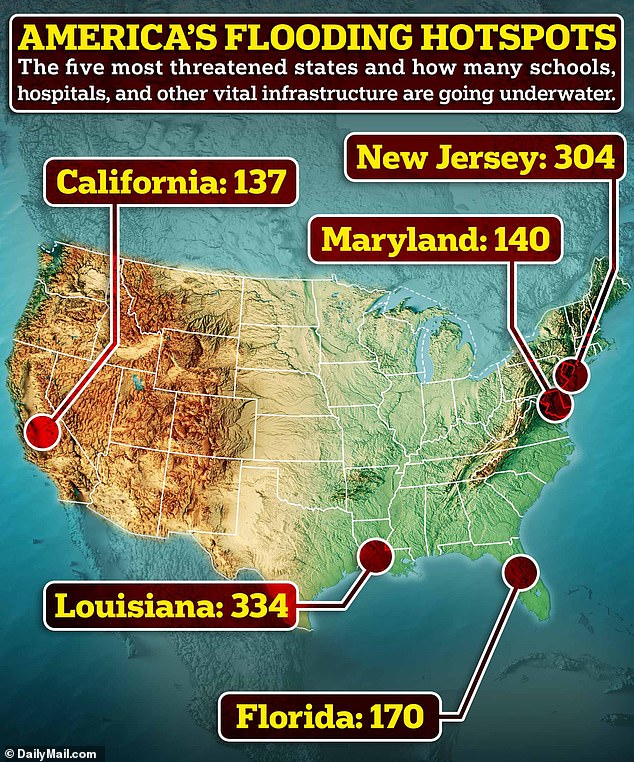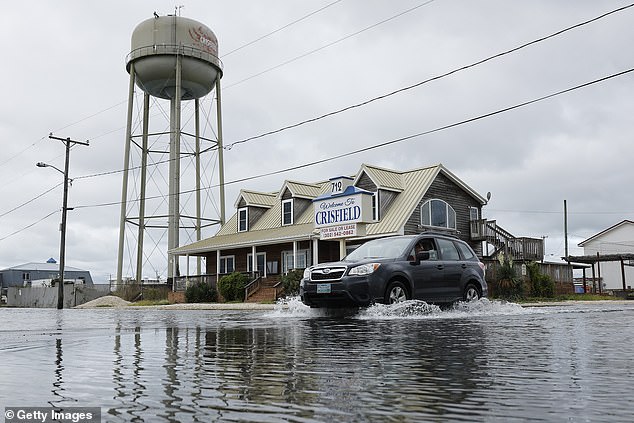The 90 million people living on America’s coasts have been put on alert.
Sea levels are rising, storms are growing fiercer, and more homes, schools and hospitals are getting flooded.
That’s the message from a shocking new report from the Union of Concerned Scientists.
Rising tides will expose more than 1,600 pieces of hey infrastructure to floods at least twice a year by mid-century, says their 20-page study.
And the Southern, coastal state of Louisiana is in the eye of the storm.

The Union of Concerned Scientists says 334 vital sites in Louisiana face frequent flooding by mid-century

A motorist navigates a flooded intersection after heavy rains in Crisfield, Maryland, one of the states most threatened by coastal flooding
The Pelican State is set to lose some 334 vital sites to floods by 2050, researchers found.
That amounts to 189 budget housing units, a dozen government offices, 23 schools, 41 health clinics, 38 energy installations, and 31 sewage plants.
Rachel Cleetus says it’s time to act against flooding
New Jersey is not far behind — the Garden State is on track to lose 304 such buildings along its 130-mile Atlantic coastline.
Florida, Maryland, and California round out the five most threatened states in the country.
The research group’s policy director Rachel Cleetus said the report was a wake-up call for ‘millions of people in coastal communities.’
‘Policymakers and public and private decision-makers must act with urgency to take protective action now,’ said Cleetus.
The report comes as Tropical Storm Debby showcases the devastating impacts of rain, wind, and floodwater along America’s eastern coast.
It crashed ashore in Florida’s Gulf Coast on Monday as a hurricane, killing at least six people and leaving 350,000 homes without power.
The storm headed overnight to Georgia and the Carolinas, threatening to drop historic amounts of rain and produce dangerous ocean surges.
Climate experts warn that storms like Debby are becoming more frequent and severe in a warming world.
This new report shows that, because of sea-level rise, flooding is getting worse even without such headline-grabbing events.
Since 2000, chronic tidal flooding — also known as sunny day flooding — increased by 400 percent in the US Southeast Atlantic, researchers found.
Along the Gulf Coast, that figure was a staggering 1,100 percent.
Currently, there are some 900 ‘critical infrastructure’ sites along the US coastlines at risk of high—tide flooding at least twice a year.
They included schools, hospitals, power stations, health clinics, and sewage treatment plants.
But that figure will jump to 1,600 by mid-century, affecting some 3 million people.
Longer term, the amount of infrastructure exposed to frequent flooding can face even steeper increases.
A satellite image of a tropical storm off the coastline of the US state of Texas
High water left cars stranded and residents unable to leave buildings in Edgewater, New Jersey, earlier this year. The Garden State is set to see worse flooding over the coming decades.
Researchers envisaged a worst-case scenario in which sea levels rose by 6 feet by the end of the century.
That would leave as many as 15,000 sites exposed to tidal flooding.
Aside from schools and hospitals, researchers also looked at wastewater facilities, government buildings and fire stations in their count.
They also included brownfield sites that could expose residents to pollutants if flooded.
Also included were public housing complexes and subsidized apartment blocks.
More than 40 percent of the roughly 150,000 assets that researchers examined for the report are public or subsidized housing.
That’s a scary number for a nation that already has a shortfall of some 7 million low-cost units.
Researchers showed how coastal communities have already seen their lives upended by flooding.
Starting in 2020, some 4,200 residents of the Tidewater Gardens in Norfolk, Virginia, were forced from their homes when officials razed their affordable housing complex to make way for a billion-dollar coastal protection scheme.
Many of them struggled to find new homes, researchers warned.
In Charleston, South Carolina, sewer overflows due to tidal flooding have sent dangerously untreated wastewater into nearby waterways.
And in Miami, Florida, developers continue to spend billions on new apartments even though they’re in devastating flood zones, researchers said.
The report is alarming for people who have bought properties along coastlines that are increasingly threatened by flooding.
They face higher insurance premiums and are in some cases just one flood away from seeing their homes damaged or tumbling in value.
Homebuyers across the US face tough choices about where to purchase, and to mitigate against the increasingly-common wildfires, floods, and other natural disasters that could destroy a prized asset.
Nearly a third of Americans have cited global warming as a reason they’re willing to move, according to a Forbes Home study.
Neighbors survey flooded streets outside their apartments following two days of heavy rains from a tropical storm in Crisfield, Maryland
Climate change is forcing people to adjust how they live – including moving to new cities – but not every town is worth packing up your life for. Ann Arbor (pictured) has seen cost of living rise six percent above the national average and an astonishing 17 percent above the Michigan average
As a result, many cities have excitedly tacked on ‘climate haven’ to the list of appeals to lure new homebuyers.
Places like Duluth, Minnesota; Ann Arbor, Michigan, and Burlington, Vermont, had been deemed ‘climate havens’ — meaning they are considered good places to live as the earth continues to warm up.
Where to go and where to avoid climate haven
Don’t Go:
– Ann Arbor, Michigan
– Madison, Wisconsin
– Burlington, Vermont
Do Go:
– Duluth, Minnesota
– Buffalo, New York
– Minneapolis, Minnesota
However — like all sustainable things — making greener choices usually comes with a higher price tag, and Americans are already drowning under the heavy weight of inflation.
But with global warming increasing the chances of more natural disasters — like hurricanes in Florida, wildfires in California, and unbearable heat in Texas — it’s left many Americans being forced to consider exiting their towns and cities for more fair-weathered places.
Ann Arbor has seen cost of living rise six percent above the national average and an astonishing 17 percent above the Michigan average, according to Go Banking Rates.
An average home costs more than $520,000 in the Midwest city, compared to the average US rate of $363,000, according to Zillow.
Madison, Wisconsin, doesn’t fare much better when it comes to saving a buck for Americans, as healthcare costs are up 24 percent and utility prices are up nine percent, Go Banking Rates said.
However, housing prices are only $30,000 higher than the average.
Burlington has eye-watering cost of living prices that would make any American cry, with it being 24 percent higher than the national average.
Even in its own state, it’s 19 percent more expensive and housing prices are up there with Ann Arbor.
But not all climate havens are terrible places for one’s wallet, as Duluth is eight percent lower than the national average for cost of living, and two percent lower for Minnesota.
Another Minnesota spot to invest in is Minneapolis, where both cost of living and housing prices are lower than the national average, according to Go Banking Rates.
If the Midwest isn’t your cup of tea, Buffalo, New York, is also a great option, with cost of living down five percent compared to the national average, the outlet reported. Utilities and groceries are also typically cheaper here, as well.
Source link : http://www.bing.com/news/apiclick.aspx?ref=FexRss&aid=&tid=66b26268ea7242c386d0abdd0c107dbc&url=https%3A%2F%2Fwww.dailymail.co.uk%2Fnews%2Farticle-13714655%2FMap-FIVE-coastal-states-worst-flood-schools-hospitals-underwater-2050.html&c=7663518869411491852&mkt=en-us
Author :
Publish date : 2024-08-06 05:00:00
Copyright for syndicated content belongs to the linked Source.
